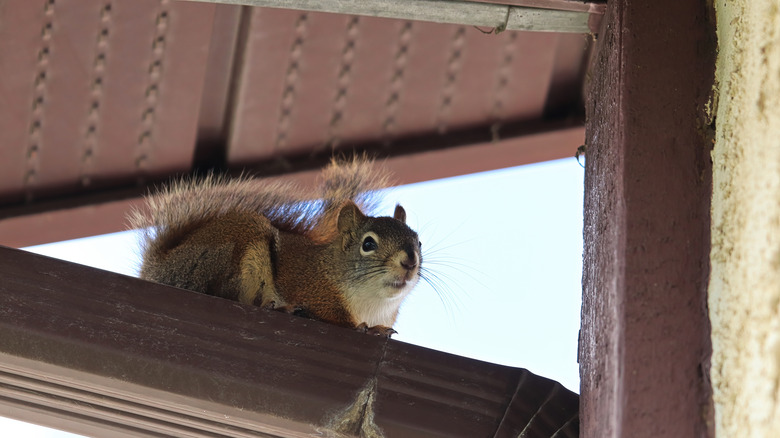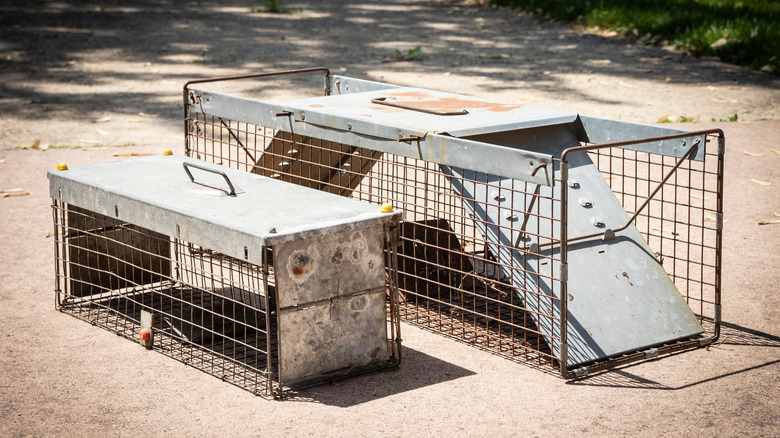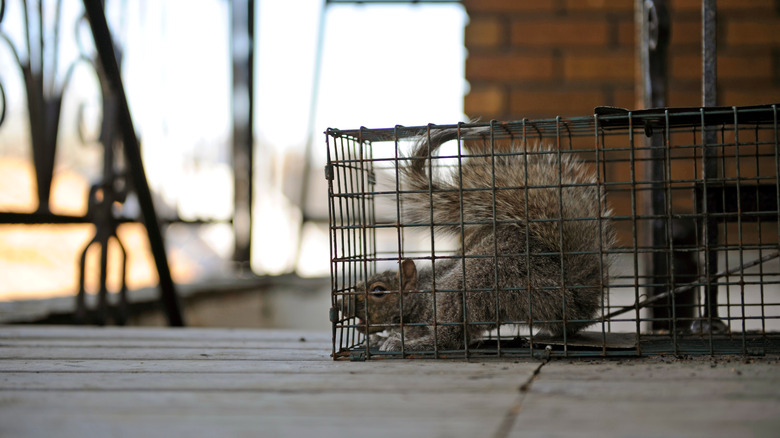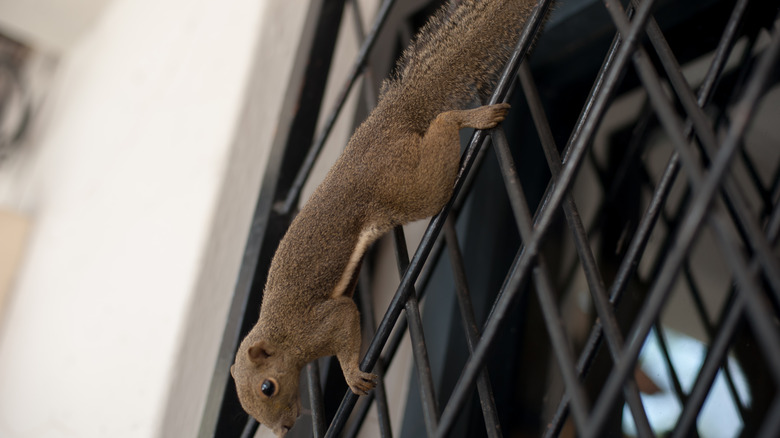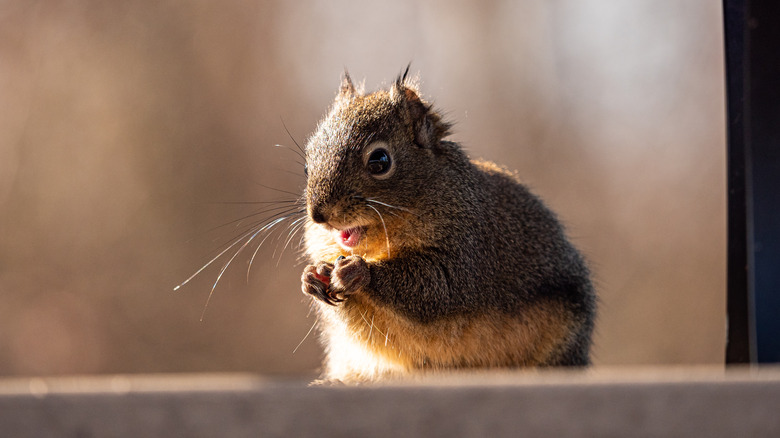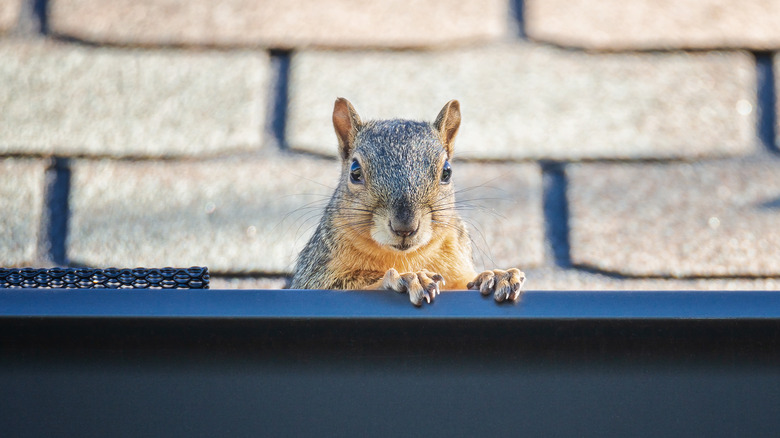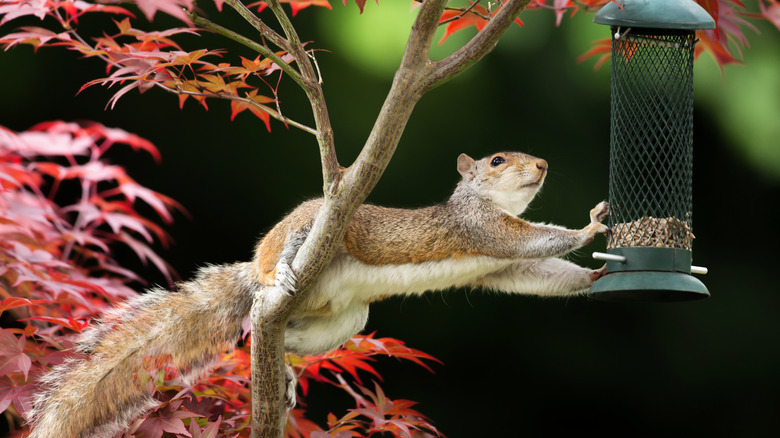Ways To Get Rid Of Squirrels In Your Attic
We may receive a commission on purchases made from links.
Having squirrels in your attic is never a pleasant experience. While these friendly rodents are generally peaceful and harmless, letting them live in your attic isn't beneficial for either of you. At best, they can chew through wood, bring in nesting materials, and drop feces, which will create minimal but certainly annoying damage and a foul scent. At worst, they can chew through electrical wiring and insulation, which can create serious home issues and even potential fires, as well as possibly kill the squirrel, leaving you with a hefty repair bill and a dead (and potentially diseased) squirrel to dispose of, as per Animals In Your Attic.
Some telltale signs that this rodent may be squatting in your attic include rustling and chewing sounds, strong odors, the presence of feces, an abundance of squirrel nests around your home (as well as lots of squirrels on your property), yard damage, and external home damage, according to Skedaddle Humane Wildlife Control. If you have or suspect you have squirrels living in your attic, don't panic just yet, as there are quite a few ways to get the pesky pests out.
1. Call wildlife control
This first option may seem obvious, but it's the most effective, and that is to call either your local animal or wildlife control center. You may have varying luck with municipal animal control groups, warns Critter Detective, as squirrel removal is not generally in their wheelhouse. Regardless, it's worth a shot. Even if they can't help with the actual service, they may be able to lend out equipment like cages.
This Old House points out that pest control companies not only have specific protocols for squirrel removal, but they'll do more than simply kick out the unwanted guests. They'll typically run a home inspection to assess how serious the issue is and then proceed to remove the rodents quickly and effectively, as well as put preventative measures in place to keep them from returning. This may not be the most cost-effective method, though. Home Advisor estimates that squirrel removal services range anywhere from $200 to $1,500.
2. Make lots of noise
According to The Spruce, squirrels are aversive to noise, activity, and the feeling of someone encroaching on their space. Before calling pest control or turning to chemical treatments, consider simply annoying the squirrels out of your attic. This can be done in a few ways — banging on the attic door with your hands, a broom, or another heavy object, yelling, hitting pots and pans together in the direction of the infestation, loudly playing a television or radio near the attic, and shining a bright spotlight inside the attic.
That being said, Terminix warns that this method can be somewhat counterproductive — if you don't properly seal off your attic, the squirrels may leave your attic, but in favor of your walls or other areas of your home. They may also get angry and defensive and potentially attack. While the CDC states that they aren't a common transmitter of rabies, they can still carry a slew of other harmful diseases.
3. Seal entry points
Some repellent methods only work when your home is properly sealed off — as Terminix says, squirrels can and will squeeze through pretty much any gap they can find, so scaring them out of your attic only works if they can't get into other parts of your home. Sealing off your windows and doors also helps prevent squirrels from coming back.
Ensure all windows and doors fit their frames property and consider installing screens for extra caution. Vents, chimney tops, and other similar openings can either be covered with a wire mesh or with a chimney cap. Any other openings can be sealed with their corresponding materials. If you need help, reach out to a pest control company for ideas on what to seal and how.
Don't turn your home into a fortress just yet, though, as the squirrels need a way to get out. Designate an exit point for the rodents and cover it with something destructible like newspaper. If you notice the paper is torn up, the squirrels have left. At this point, you can seal it up permanently.
4. Set up squirrel traps
If scaring the squirrel out of your attic doesn't work, it may be a good idea to consider setting up a squirrel trap. There are a few ways to go about this, but it is always recommended to take the humane, non-violent route first — the squirrels aren't purposely trying to be bothersome, but just enjoy the safety and warmth of your attic, explains The Spruce.
When deciding what trap to use, Attics and More recommends using small traps, as a trapped squirrel can panic and hurt itself in a larger one. After sealing all entry points in your home, set up the trap by the designated exit point. You'll also want to check frequently to make sure you're not waiting too long to release the trapped squirrels, as they could hurt themselves or die of thirst or hunger.
Bob Vila recommends box traps to humanely catch the attic-dwelling rodents. To use them, set a piece of bait on the plate of the cage. When the squirrel goes after the bait, it will trip a mechanism that closes the cage door behind it.
5. Use commercial repellents
If the other methods aren't proving effective, it may be time to consider using a commercial squirrel repellent. Most squirrel repellents are designed to keep them away from your garden or flower beds, but they can also be effective at removing squirrels from your attic and preventing their return.
Which repellent to choose can be a daunting task with so many products on the market. Luckily, Pest Samurai has narrowed down the choices to a few select repellents. One item they recommend isn't a chemical repellent but an ultrasonic pressure machine, which is similar to creating noise and will encourage the squirrels to flee your attic.
Additional products include dried blood (which will scare the squirrels into thinking there are nearby predators), a peppermint-oil-based repellent, and other company-specific repellant formulas, which will likely include ingredients like eggs, cinnamon, and rosemary (like this Messina Squirrel Stopper formula) or garlic, lemongrass, clove, and cedarwood (like this I Must Garden Squirrel Repellent).
6. DIY squirrel repellent
If commercial pesticides aren't your thing, you can very easily make your own. One natural squirrel repellent is hot sauce, per SFGate. While this is mostly for gardens, it will certainly still repel the rodents from your attic. Mix a small bottle of hot sauce with a gallon of water and add to a spray bottle, spritzing wherever the squirrels cause problems. This can be a good prevention tool as well — consider spraying the branches of tall trees that provide access to your attic.
Another effective squirrel repellent is mothballs, recommends Animal Sake. Many chemical pesticides use the same ingredients that are found in mothballs, making them potent repellents since squirrels abhor the scent. Simply scatter a few around your attic and wait for the squirrels to leave. Rags soaked in apple cider vinegar work similarly, advises The Spruce.
Hair bags are another great way to scare off attic-dwelling squirrels, according to Hunker. Human hair works, but dog hair is incredibly potent since this animal is a natural squirrel predator. Simply fill a small bag made of cheesecloth with the hair, tie it up, and place it in the attic.
7. Strobe lights running for 24 hours
According to Humane Pest Control Tips, strobe lights can effectively deter rodents, including squirrels. In order to be effective, these lights need to be bright and intense. You'll also need to run the light all day and night for it to work. Some attic spaces may require multiple strategically placed strobe lights for full coverage. Otherwise, squirrels might just hunker down in a dark corner rather than leave the attic completely.
There are some tips to keep in mind when utilizing this strategy. Make sure you use quality extension cords and inspect them regularly for frays or evidence of mischievous squirrel nibbles. And the last thing you want is to drive the squirrel downwards into your home instead of outside. So, you'll also want to make sure you seal any access from the attic to the main part of your home. Also, be mindful about where you set up your strobe lights so they aren't blocked and can be visible from as much of the attic as possible.
8. Set up a one-way door
Professional Wildlife Removal points out that a one-way exclusion door can be an effective way to get squirrels out of your attic. These cages are mounted to the entry point the squirrels use to gain access to your attic. The contraption consists of a spring that only allows the door to open to exit. You can also opt for a DIY funnel design made of metal wire that allows for passage one way, out of the attic. However, the funnel's narrow end must be just the right size to prevent the squirrel from re-entering.
For this method to be effective, you need to pinpoint exactly where the squirrels are gaining access to your attic space. You'll also want to seal any other potential access points. If squirrels have a supply of food in the attic, they may not need to leave. This means you might need to use another strategy to drive the squirrels out in combination with this one-way door technique.
9. Preventive measures
Finally, make sure you're implementing preventive measures to keep the squirrels from re-entering your attic. As discussed earlier, one of the most important things you can do to effectively keep squirrels out of your attic is properly sealing off every possible access point into your home. However, it doesn't stop there.
There are a few ways squirrels may wind up having access to your attic. A major one is tall trees, warns Terminix. You will want to cut the branches back to prevent the squirrels from reaching your attic.
Squirrels also love bird feeders, which are commonly placed in trees and can encourage these critters to climb up them and then into your attic. You can prevent this by purchasing a squirrel-proof bird feeder, advises The Spruce. If this doesn't work, consider greasing up the feeder, which won't affect the birds, says Tips Bulletin. Lastly, you can place a squirrel-specific feeder away from your home to satiate the neighborhood squirrels while keeping them out of your attic.
